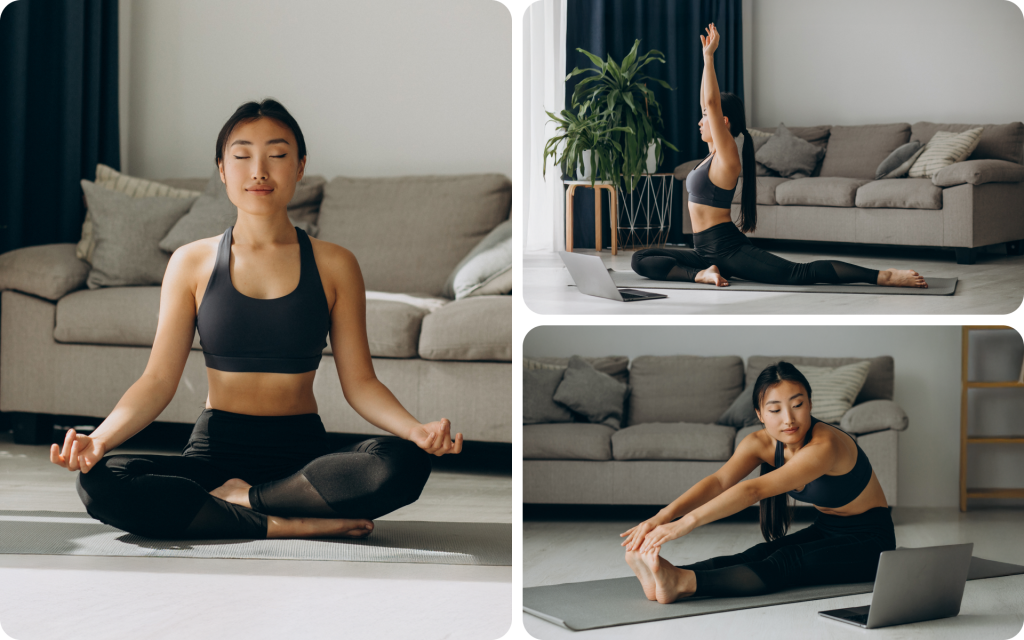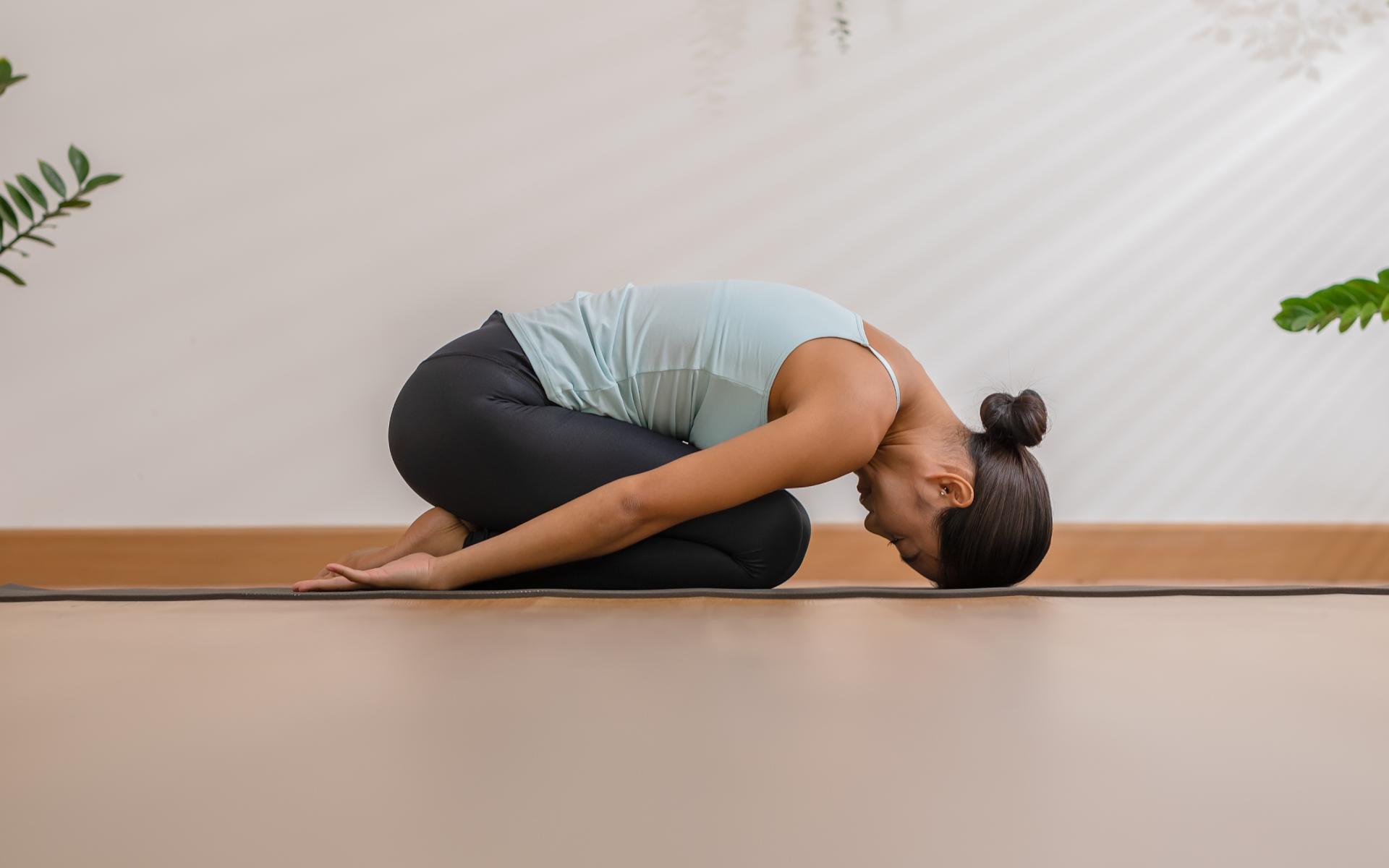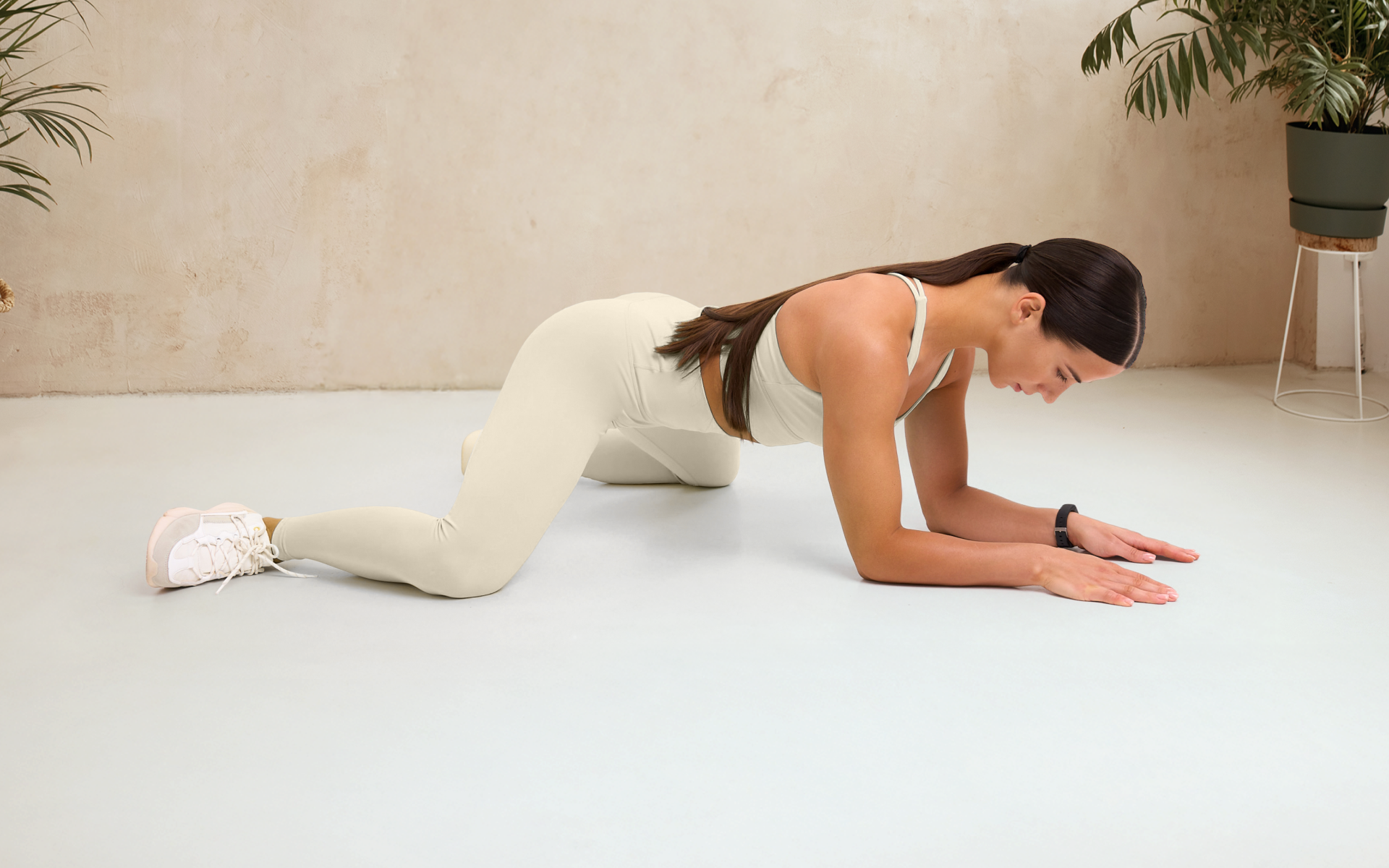Have you ever felt as if your body is tense, your mind is scattered, and you just can’t feel grounded? This tension is often a sign that somatic meditation may be a helpful way to help alleviate these symptoms (1).
Sometimes, it can feel like you’re just going through the motions, often leaving you stressed or overwhelmed. In a society that teaches us to suppress or ignore our emotions, it’s no wonder that so many people feel stuck in a constant state of tension (2). However, the truth is that when we learn to listen to our bodies and allow emotions to surface, those feelings can move through us instead of being trapped.
This article will explore what somatic meditation is, its benefits, practical ways to engage in somatic meditation, and how to begin your practice.
What Is A Somatic Meditation?
Somatic meditation is a body-centered form of mindfulness meditation that focuses on tuning into internal sensations, emotions, and physical tension (3, 4).
Unlike traditional forms of meditation that often focus solely on breath or thoughts, somatic meditations invite you to tune in to what’s happening deeper within the body, such as a tight chest, clenched jaw, or other subtle physical cues (5).
This practice originates from the concept that the body retains emotional experiences, particularly unprocessed stress and trauma (6). By slowing down and bringing awareness to these sensations, you may create space for emotional release and regulation (3, 7). The goal isn’t to “fix” or force anything but to listen inward and allow your body to guide the healing process.
Before starting any new somatic practice, it’s a good idea to consult with your doctor.
They can help determine whether this approach aligns with your current health needs and goals while offering personalized advice tailored to your unique situation.
How Somatic Practices Work
Before diving straight in, it’s helpful to understand how somatic practices work and why they’re gaining attention. Learning how the mind and body interact to support emotional release can make your practice more effective and help you engage with it more intentionally.
What Do Somatic Practices Do?
Somatic practices may help slow things down, guiding you to more easily notice physical sensations and emotions without judgment (3).
Benefits of somatic practices may include (8, 9, 10):
- Better mind-body awareness
- Relief from stress and anxiety
- Improved emotional regulation
- Relief from chronic tension or pain
- Support for trauma recovery (when guided by a mental health professional)
BetterMe: Health Coaching app helps you achieve your body goals with ease and efficiency by helping to choose proper meal plans and effective workouts. Start using our app and you will see good results in a short time.
Can I Support My Body Through Meditation?
Somatic meditations may be a powerful tool for supporting mental and physical well-being by helping you become more aware of your body’s subtle cues (5).
However, it’s essential to understand that meditation alone is not a cure and should not be used as a replacement for professional medical or mental health care.
If you’re dealing with physical or mental health concerns, always consult with your primary care physician first. They can help you decide whether somatic practices are right for your situation while offering personalized advice along the way.
If you choose to explore this path and have mental health concerns, consider working with a licensed somatic therapist to ensure your healing process is safe, effective, and trauma-informed. You can find reputable somatic providers in your area by searching online or asking your primary care physician for a referral.
Read more: Meditative Movement: How Mindfulness and Exercise Work Together
How To Get Started With Somatic Healing
How do I start somatic exercise? Beginning a somatic practice doesn’t have to be complicated. Whether you’re new to mind-body work or already familiar with meditations, the key is to start slow, listen to your body, and focus on consistency rather than intensity.
Can You Do Somatic Practices By Yourself?
Yes, you can engage in somatic practices on your own as long as you don’t have any existing health concerns or have been cleared by your doctor.
Somatic experiencing meditations, such as body scans and deep breathing, are simple yet effective ways to begin somatic healing at your own pace (11).
That said, if you’re dealing with trauma, chronic stress, or other emotional challenges, working with a licensed somatic therapist is highly recommended.
They can help guide the process safely and offer personalized support, especially if intense emotions arise during your sessions (12).
How Can I Practice Somatic Meditation Correctly?
There’s no single “perfect” way to engage in somatic practices, but starting with a few foundational steps can help you feel more grounded and in tune with your body:
- Find a quiet space where you can sit or lie down comfortably.
- Begin your session with simple breath awareness, taking slow and deep breaths to calm your nervous system and settle into your body (13).
- Tune into physical sensations as you move by gently scanning your body for areas of tension, warmth, pressure, or other internal cues (8).
- Stay present without judgment, allowing any emotions or sensations to arise naturally without trying to change or suppress them (3, 14).
- Close your session with grounding, such as feeling your feet on the floor or naming objects around you, to reorient yourself in the present moment (15).
Even simple, everyday movements can become somatic practices when incorporating these steps (16), such as:
- Stretching your arms
- Rolling your shoulders
- Adjusting your posture
Remember, it’s less about the movement itself and more about how you engage with it internally.
Examples Of Somatic Meditations
There are many ways to approach somatic meditations, each tailored to support different needs and goals.
Here are some somatic meditation examples to consider:
- Somatic meditation for sleep: These meditation sessions often involve relaxing techniques such as body scans and deep breathing to calm the nervous system before rest (11).
- Grounding guided meditation: Uses your senses and surroundings to help you reconnect with your body and anchor yourself in the present moment (17).
- Somatic meditation script: Offers structured, step-by-step guidance (usually in audio or text form) for those who prefer a more transparent, organized approach (18).
- Somatic meditation to release trauma: Uses somatic principles to improve awareness to help regulate emotions and release trauma (9, 19).
- Somatic yoga exercises: Combines gentle yoga poses with mindful meditation and increased awareness to strengthen the mind-body connection (20, 21).
If you’re looking for guided support, the BetterMe app offers a wide range of somatic practices tailored to meet you wherever you’re in your journey.
Somatic Practices Through Yoga
One of the most accessible and effective somatic practices is yoga, particularly somatic yoga. Unlike fast-paced or rigid yoga styles, somatic yoga emphasizes slow, mindful movements to help you tune in to how your body feels in the present moment (21, 22).
Does Somatic Yoga Work For Beginners?
Yes, somatic yoga is especially well-suited for beginners, as it focuses on awareness rather than intensity (22). You don’t need to be flexible or have any prior experience to benefit from the practice.
Many somatic yoga exercises for beginners at home are simple, accessible, and require no special equipment besides a quiet space, an open mind, and a willingness to listen to your body. These slow, intentional movements can help you stay connected to your body’s signals without pushing beyond your limits (23).
What Are Some Examples Of Somatic Yoga Exercises For Beginners?
If you’re new to somatic yoga, what are some somatic yoga exercises for beginners?
The following beginner-friendly somatic stretching exercises and somatic yoga moves are a great place to start (22):
Child’s Pose (Balasana):
- Begin by kneeling on your mat with your big toes touching and knees apart.
- Slowly fold your torso forward, extending your arms out in front of you or resting them alongside your body.
- Let your forehead rest on the floor in front of you.
- Breathe deeply into your belly and lower back, allowing your body to soften with each exhale.
- Notice any areas of tension and try to release it with each deep breath you take.
Bridge Pose (Setu Bandhasana):
- Lie flat on your back with your knees bent and feet on the floor, hip-width apart.
- Place your arms comfortably by your sides.
- Press your feet and shoulders into the mat as you gently lift your hips toward the ceiling, keeping your thighs parallel to each other.
- Hold for a few deep breaths, then slowly and gently lower your spine back down, one vertebra at a time.
- Repeat this process, paying close attention to the subtle sensations in your body.
Cat-Cow Stretch (Marjaryasana-Bitilasana):
- Come onto your hands and knees, wrists aligned with your shoulders, and knees aligned with your hips.
- Inhale as you drop your belly, lift your tailbone, and look upward (cow pose).
- Exhale as you round your spine, tucking your chin toward your chest and drawing your stomach toward the ceiling (cat pose).
- Move through these two poses slowly and mindfully, letting your breath guide the transition between each shape.
How Often Should You Do Somatic Yoga For Beginners?
For beginners, starting with 2-3 weekly sessions, even if they’re just 10-15 minutes long, can help get your routine going. As your comfort with somatic yoga grows, you can increase the frequency or consider integrating shorter daily practices. Always consult with your healthcare provider before establishing a new exercise routine.
Read more: Does Somatic Pilates Really Work for Weight Loss?
Do Somatic Exercises Actually Work?
Many people find somatic exercises effective for reducing stress, improving emotional balance, and easing tension (8, 9). However, individual results can vary based on your health needs, goals, consistency, and other factors.
Whether you’re a workout beast or just a beginner making your first foray into the world of fitness and dieting – BetterMe has a lot to offer to both newbies and experts! Install the app and experience the versatility first-hand!
How Long Does It Take For Somatic Exercises To Work?
Everyone’s experience with somatic exercises is different. Some people may notice somatic yoga benefits right away, while others may take weeks, months, or even longer to experience noticeable changes and relief.
Factors such as your current stress levels, physical condition, emotional state, and the consistency of your practice all play a role (24). The key is to stay patient and approach each session with curiosity rather than expectation. Over time, even small moments of mindful movement may be a step forward in making meaningful changes. If you’re curious about somatic yoga for weight loss, check out our earlier article
What Time Of Day Is Best To Do Somatic Exercises?
There’s no one-size-fits-all time to practice somatic exercises, so the ideal time of day will depend on what fits best with your lifestyle and daily routine. That said, here are a few standard times people find helpful (25):
- Morning: A great way to ease into your day with calm, focused energy while releasing any overnight stiffness or tension.
- Evening: Helps you wind down by releasing stress and muscle tightness built up throughout the day, setting the stage for a restful sleep.
- Midday: Ideal for re-centering yourself when you feel mentally drained or tense, this mindful pause provides a reset for both your body and mind throughout the day.
Pre- and post-workout: Can support recovery by relieving built-up tension and improving body awareness before or after intense physical activity.
Yes, somatic therapy is an evidence-based practice, though research in the field is still evolving (9, 26). Experts often use the practice to help patients address trauma, stress, or other emotional difficulties through body-based techniques, so working with a licensed somatic therapist is crucial for a safe and practical experience. A somatic release can feel different for everyone, but it typically involves a physical or emotional sensation of releasing tension. This feeling may include a sense of tension softening, a deep sigh, or even tears (27). While these experiences can feel intense, they should never be painful or overwhelming. If something doesn’t feel right, it’s essential to consult with your doctor or therapist before proceeding. Somatic therapy is often especially beneficial for those dealing with mental health challenges who haven’t found relief through traditional talk therapy (26). Conditions such as post-traumatic stress disorder, anxiety, depression, grief, and low self-esteem can manifest physically in the body, and working with a somatic therapist may be a way to bring awareness to these sensations and support a healthier process of emotional release. Crying during somatic work is a normal response (27). It can occur when the body releases stored emotions or unresolved stress, which is a natural part of the healing process and shouldn’t be viewed as negative. However, if your emotions feel too strong to manage alone, be sure to speak with your doctor or therapist for support and safety.Frequently Asked Questions
Is somatic therapy legit?
What does a somatic release feel like?
Who needs somatic therapy?
Why do people cry during somatic exercises?
The Bottom Line
The next time you feel drained, tense, or disconnected, try a somatic meditation to recenter yourself and reconnect with your mind and body. For ongoing support, consider consulting a somatic therapist to help you find the approach that best suits your needs.
As you approach this technique, keep in mind that somatic practices are about how you feel on the inside, not how you appear from the outside. Remember to stay curious, move at your own pace, and trust your body to lead the way.
If you’re looking for more support, the BetterMe app offers guided tutorials, tips, and other resources to help guide you along your healing journey.
DISCLAIMER:
This article is intended for general informational purposes only and does not serve to address individual circumstances. It is not a substitute for professional advice or help and should not be relied on for making any kind of decision-making. Any action taken as a direct or indirect result of the information in this article is entirely at your own risk and is your sole responsibility.
BetterMe, its content staff, and its medical advisors accept no responsibility for inaccuracies, errors, misstatements, inconsistencies, or omissions and specifically disclaim any liability, loss or risk, personal, professional or otherwise, which may be incurred as a consequence, directly or indirectly, of the use and/or application of any content.
You should always seek the advice of your physician or other qualified health provider with any questions you may have regarding a medical condition or your specific situation. Never disregard professional medical advice or delay seeking it because of BetterMe content. If you suspect or think you may have a medical emergency, call your doctor.
SOURCES:
- Grounding truth in the body: Therapy and research renewed (2010, tandfonline.com)
- The Social Costs of Emotional Suppression: A Prospective Study of the Transition to College (2014, nih.gov)
- Mindfulness, Interoception, and the Body: A Contemporary Perspective (2019, nih.gov)
- Finding Our Way Back into the Body Through Somatic Movement: A Journey Through the Meanings and Challenges of Mindfulness (2024, digitalcommons.lesley.edu)
- Somatic Experiencing: using interoception and proprioception as core elements of trauma therapy (2015, nih.gov)
- Clinical Manifestations of Body Memories: The Impact of Past Bodily Experiences on Mental Health (2022, nih.gov)
- Levels of Emotional Awareness: Theory and Measurement of a Socio-Emotional Skill (2021, nih.gov)
- The Body Can Balance the Score: Using a Somatic Self-Care Intervention to Support Well-Being and Promote Healing (2025, nih.gov)
- Somatic experiencing – effectiveness and key factors of body-oriented trauma therapy: a scoping literature review (2021, nih.gov)
- Moving With Pain: What Principles From Somatic Practices Can Offer to People Living With Chronic Pain (2021, frontiersin.org)
- Effectiveness of Deep Breathing and Body Scan Meditation Combined with Music to Improve Sleep Quality and Quality of Life in Older Adults (2020, sciencedirect.com)
- The Role of Safety in Change-Promoting Therapeutic Relationships: An Integrative Relational Approach (2024, nih.gov)
- Breathing Practices for Stress and Anxiety Reduction: Conceptual Framework of Implementation Guidelines Based on a Systematic Review of the Published Literature (2023, nih.gov)
- Effects of Mindfulness on Psychological Health: A Review of Empirical Studies (2013, nih.gov)
- Exhibit 1.4-1: Grounding Techniques (2014, nih.gov)
- Moving with Somatic Awareness (2013, tandfonline.com)
- Grounding the Connection Between Psyche and Soma: Creating a Reliable Observation Tool for Grounding Assessment in an Adult Population (2021, nih.gov)
- Use of Mobile Apps and Online Programs of Mindfulness and Self-Compassion Training in Workers: A Scoping Review (2022, nih.gov)
- Meditation and Yoga for Posttraumatic Stress Disorder: A Meta-Analytic Review of Randomized Controlled Trials (2018, nih.gov)
- Exploring the therapeutic effects of yoga and its ability to increase quality of life (2011, nih.gov)
- Impact of Somatic Yoga and Meditation on Fall Risk, Function, and Quality of Life for Chemotherapy-Induced Peripheral Neuropathy Syndrome in Cancer Survivors (2019, nih.gov)
- What Is Somatic Yoga? (2025, health.clevelandclinic.org)
- Mindful movement and skilled attention (2015, nih.gov)
- Attitudes, knowledge, and understanding towards mind-body practices as an asset for social prescribing in higher education (2023, tandfonline.com)
- “I Rest as I Move”: Exhaustion, Fatigue, and Somatic Movement (2023, liebertpub.com)
- What is somatic therapy? (2023, health.harvard.edu)
- Somatic Therapy: Signs Your Body Is Releasing Trauma (2024, integrishealth.org)











